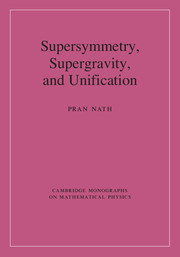Book contents
- Frontmatter
- Dedication
- Contents
- Preface
- 1 A Brief History of Unification
- 2 Gravitation
- 3 Non-abelian Gauge Theory
- 4 Spontaneous Breaking of Global and Local Symmetries
- 5 The Standard Model
- 6 Anomalies
- 7 Effective Lagrangians
- 8 Supersymmetry
- 9 Grand Unification
- 10 The MSSM Lagrangian
- 11 N = 1 Supergravity
- 12 Coupling of Supergravity with Matter and Gauge Fields
- 13 Supergravity Grand Unification
- 14 Phenomenology of Supergravity Grand Unification
- 15 CP Violation in Supergravity Unified Theories
- 16 Proton Stability in Supergravity Unified Theories
- 17 Cosmology, Astroparticle Physics, and Supergravity Unification
- 18 Extended Supergravities and Supergravities from Superstrings
- 19 Specialized Topics
- 20 The Future of Unification
- 21 Appendices
- 22 Notation, Conventions, and Formulae
- 23 Constants and Units
- 24 Further Reading
- Author Index
- Subject Index
- References
16 - Proton Stability in Supergravity Unified Theories
Published online by Cambridge University Press: 30 December 2016
- Frontmatter
- Dedication
- Contents
- Preface
- 1 A Brief History of Unification
- 2 Gravitation
- 3 Non-abelian Gauge Theory
- 4 Spontaneous Breaking of Global and Local Symmetries
- 5 The Standard Model
- 6 Anomalies
- 7 Effective Lagrangians
- 8 Supersymmetry
- 9 Grand Unification
- 10 The MSSM Lagrangian
- 11 N = 1 Supergravity
- 12 Coupling of Supergravity with Matter and Gauge Fields
- 13 Supergravity Grand Unification
- 14 Phenomenology of Supergravity Grand Unification
- 15 CP Violation in Supergravity Unified Theories
- 16 Proton Stability in Supergravity Unified Theories
- 17 Cosmology, Astroparticle Physics, and Supergravity Unification
- 18 Extended Supergravities and Supergravities from Superstrings
- 19 Specialized Topics
- 20 The Future of Unification
- 21 Appendices
- 22 Notation, Conventions, and Formulae
- 23 Constants and Units
- 24 Further Reading
- Author Index
- Subject Index
- References
Summary
Baryon number in particle theory has been of interest for several decades. In 1929 Herman Weyl [1] conjectured such a conservation, and later in 1938 Stueckelberg [2] made it more concrete. This was done by postulating different transformation laws for light particles and heavy particles where the leptons were the light and the nucleons the heavy particles. The conservation of baryons was put on an equal footing to the conservation of the electric charge in further work by Wigner [3]. On the experimental side, the earliest work on putting a lower limit on the proton lifetime was by Goldhaber [4]. In 1954 Goldhaber proposed that spontaneous fission of Th232 after excitation by nucleon decay would be followed by a rearrangement energy due to the loss of a nucleon, and this would cause fission of the residual nucleus. This allowed Goldhaber to put a lower limit of 1.4 × 1014 years on the nucleon lifetime. This limit was soon improved to a lower limit of 1 × 1022 years for bound nucleons in a direct experiment using a liquid scintillation counter 30 m below the Earth's surface by Reines, Cowan, and Goldhaber [5] (for a review of the early history of experiment on proton lifetime limits see Gurr et al. [6] and Perkins [7], and for a broad overview of proton stability in grand unified theories, strings, and branes see Nath and Fileviez Perez [8]). On the theoretical side, an issue arose regarding the absolute conservation of baryon number. It was pointed out by Lee and Yang [9] that if heavy particle number is the result of a gauge invariance, there would be a longrange force associated with such a conservation, but no such long range force is observed. On the other hand, if baryon number is a global symmetry, there is no reason that a global symmetry would guarantee an absolute conservation of baryon number. Indeed, such a symmetry would be violated by anomalies [10] and by gravitational interactions [11–14], specifically worm hole effects [15]. The first concrete model for proton decay via a possible new superweak interaction was discussed by Yamaguchi in 1959 [16]. This work stimulated the first deep underground proton decay experiment in 1960 [7, 17].
- Type
- Chapter
- Information
- Supersymmetry, Supergravity, and Unification , pp. 335 - 352Publisher: Cambridge University PressPrint publication year: 2016



